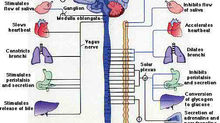Sympathetic and Parasympathetic Nervous System and Meditation
- tomjlynam

- Oct 6, 2014
- 2 min read
The nervous system can be divided into two parts, the sympathetic and the parasympathetic. The level of respective activity of each system dictates many of the functions within the body. When at rest the parasympathetic is more dominant, stimulating digestion, constricting pupils, slowing heart rate, basically channeling the bodies energies into long term activities such as reproduction, muscle growth and fat storage. When the body is stressed the sympathetic system becomes more dominant. Its purpose is to marshall functions of the body which help in dealing with threat, or perceived threat, and this includes raising heart rate, breaking fats into sugars, and dilating the airways; all necessary to fulfil the demands of the fight or flight response. When we are not slobbing about, and not feeling in immediate danger, the opposing systems serve to provide a balance and will work within contextual norms to maintain an optimum eqilibrium.
Various belief and lifestyle frameworks have consciously or unconsciously placed great emphasis upon breathing; Yoga, Tai Chi, Buddhism, and conspicuously when particpants are in very relaxed states their outbreath is particularly elongated. Many religions employ singing, chanting and recitation as part of their prayer, and this unbroken production of noise also requires the outbreath to be extended. When we breathe in we activate the sympathetic nervous system (associated with the stress response) and when we breathe out we activate the parasympathetic system. The consequence being that an elongated out breath is the vehicle which takes us into states of rest and relaxation, and if this is practiced for extended periods the mind is encouraged into the feelings of deep peace often cited by buddhists during meditation, or by Catholics during their liturgy.
We can use this knowledge in our everyday lives to restore ourselves to a relaxed state when things are getting too much or in preparation for a situation we may find challenging. Taking deep inward breaths and letting them out slowly will reduce your heart rate and make you feel more relaxed, a very simple but tried and tested technique people have been using for thousands of years without knowledge of the nervous system to calm their minds.









Comments